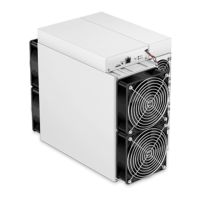
Do you have a question about the BITMAIN ANTMINER S19j and is the answer not in the manual?
| Hash Rate | 90 TH/s |
|---|---|
| Noise Level | 75 dB |
| Weight | 13.2 kg |
| Network Connection | Ethernet |
| Algorithm | SHA-256 |
| Efficiency | 34.5 J/TH |
| Operating Temperature | 0°C to 40°C |
| Voltage | 220V - 240V |
| Power Consumption | 3250 W |
| Dimensions | 370 x 195.5 x 290 mm |
| Chip | BM1362 |
Critical safety instructions and usage guidelines, including power connection and handling.
Identifies main hardware components and front/back views of the S19j server.
Explains control panel variations and the APW12 power supply unit, including connections.
Lists detailed technical specifications for various S19j models, including performance and environmental data.
Instructions for using the IPReporter.zip tool to find and set up the server's IP address.
Steps to access the server's web interface, enter the IP address, and configure network settings.
Details on configuring hostname, protocol (DHCP/Static), and other network parameters via the web interface.
Details how to configure mining pools, including addresses, worker IDs, and passwords for optimal mining operations.
Explains the server's operating modes (Normal/Sleep) and how to adjust fan speed settings.
Guides users to the dashboard for real-time monitoring of hashrate, network, fan speed, and temperature.
Details how to monitor critical metrics such as chip state, frequency, hashrate, and temperatures.
Explains server behavior and error messages when outlet temperature exceeds safety limits.
Guides users on how to locate and verify the current firmware version installed on the server.
Details the steps and crucial precautions for performing a firmware upgrade on the server.
Instructions on how to change the server's login password for security.
Steps to reset the server to its default factory settings, including a warning about the red LED.
Specifies the required operating temperature, humidity, storage conditions, and altitude limits.
Outlines distance requirements from pollution sources and seaside/salt lakes for the server room.
Advises on keeping the site away from high-voltage equipment and radio transmitters.
Details requirements for dust levels and limits for various corrosive gases in the server environment.
Information regarding FCC rules, compliance conditions, and potential interference issues.
Instructions for users in the European Union on proper disposal of waste equipment.
Details the presence of restricted hazardous substances in components according to Taiwan ROHS standards.
